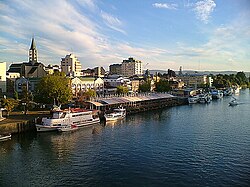Bierfest Valdivia
| Valdivia | ||||||
|---|---|---|---|---|---|---|
| City and Commune | ||||||

View of Valdivia from Pedro de Valdivia Bridge
|
||||||
|
||||||
| Nickname(s): The City of Rivers | ||||||
| Motto: Muy Noble y Muy Leal ("Most noble and most loyal") |
||||||
| Coordinates: 39°48′50″S 73°14′45″W / 39.81389°S 73.24583°WCoordinates: 39°48′50″S 73°14′45″W / 39.81389°S 73.24583°W | ||||||
| Country |
|
|||||
| Region | Los Ríos | |||||
| Province | Valdivia | |||||
| Founded as | Santa María la Blanca de Valdivia | |||||
| Founded | 9 February 1552 | |||||
| Government | ||||||
| • Type | Municipality | |||||
| • Alcalde | Omar Sabat Guzmán (UDI) | |||||
| Area | ||||||
| • Total | 1,015.6 km2 (392.1 sq mi) | |||||
| Elevation | 5 m (16 ft) | |||||
| Population (2012 Census) | ||||||
| • Total | 154,432 | |||||
| • Density | 150/km2 (390/sq mi) | |||||
| • Urban | 129,952 | |||||
| • Rural | 10,607 | |||||
| Demonym(s) | ||||||
| Sex | ||||||
| • Men | 68,510 | |||||
| • Women | 72,049 | |||||
| Time zone | CLT (UTC−04:00) | |||||
| • Summer (DST) | CLST (UTC−03:00) | |||||
| Postal code | 5090000 | |||||
| Area code(s) | country 56 + city 63 | |||||
| Climate | Cfb | |||||
| Website | Municipality of Valdivia (in Spanish) | |||||
Valdivia (Spanish pronunciation: [balˈdiβja]) is a city and commune in southern Chile, administered by the Municipality of Valdivia. The city is named after its founder Pedro de Valdivia and is located at the confluence of the Calle-Calle, Valdivia, and Cau-Cau Rivers, approximately 15 km (9 mi) east of the coastal towns of Corral and Niebla. Since October 2007, Valdivia has been the capital of Los Ríos Region and is also the capital of Valdivia Province. The national census of 2002 recorded the commune of Valdivia as having 140,559 inhabitants (Valdivianos), of whom 127,750 were living in the city. The main economic activities of Valdivia include tourism, wood pulp manufacturing, forestry, metallurgy, and beer production. The city is also the home of the Austral University of Chile, founded in 1954, the Universidad San Sebastian (founded in Concepción, 1992) and the Centro de Estudios Científicos.
The city of Valdivia and the Chiloé Archipelago were once the two southernmost outliers of the Spanish Empire. From 1645 to 1740 the city depended directly on the Viceroyalty of Peru, which financed the building of the Valdivian fort system that turned Valdivia into one of the most fortified cities of the New World. In the second half of the 19th century, Valdivia was the port of entry for German immigrants who settled in the city and surrounding areas.
...
Wikipedia




